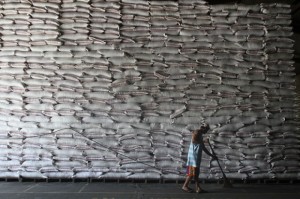PH to import 1.3 M tons of rice this year
MANILA—The math doesn’t add up.
Rice self-sufficiency is projected to reach 98 percent this year, better than last year, but government is poised to import 800,000 more million metric tons of rice than last year, Agriculture Secretary Proceso Alcala told lawmakers on Wednesday.
This prompted Bayan Muna Rep. Neri Colmenares to comment that “the math doesn’t add up.”
In 2013, at a rice self-sufficiency accomplishment of 96 percent, the government imported only 500,000 metric tons of rice to fill the four percent gap.
“So why are we importing 1.3 million metric tons when rice self-sufficiency will improve to 98 percent this year?” asked Colmenares, the senior deputy minority leader.
To which Alcala replied: “This is the reality. We’re not looking at 1:1. 100 percent is 100 percent, but the NFA (National Food Authority) needs to have a buffer. We may have good production, but we have more expensive rice.”
“Our consumers will get angry,” he added, explaining that the average price of rice would shoot up unless the NFA had enough buffer stocks to help keep prices stable.
For 2014, Alcala said, demand was projected at 12.9 million tons, while total production of palay (unmilled rice) was projected at 19.06 million tons, which would yield 12.38 million tons of rice.
“We will reach between 96 and 98 percent rice self-sufficiency,” he said.
On Wednesday, Alcala presented to the appropriations committee of the House of Representatives the Department of Agriculture’s proposed P88 billion budget for 2015.
Alcala acknowledged Colmenares’ question about the apparent discrepancy between rice self-sufficiency and importation.
“That’s the reason we have to help the farmers to produce their palay at a lower cost. That’s the reason we’re asking Congress to help farmers with post-harvest facilities, farm mechanization, technology.”
Alcala defended the additional importation, saying “it helps to keep prices of rice at a lower price.”
“The traders know what the NFA has. They have the supply… There’s enough supply coming in, which proves there will be buffer stock, so the price of rice may be sold at a lower price,” he said.
He said local rice production in 2013 reached 18.4 million tons, the “highest ever yield.”
“In 2010, rice self-sufficiency was at 82 percent. At end of last year, we reached 96 percent. We didn’t hit 100 percent, but from 82 percent to 92 percent, that shows we’re doing something right,” Alcala said.
He also noted that importation actually fell in the past three years compared to the period between 2008 and 2010, when the Philippines, the world’s largest rice importer, imported 2.4 million tons of rice.
“Some P147 billion was saved from rice importation alone. This shows the funds we have been investing in rice programs are being spent wisely,” Alcala said.
